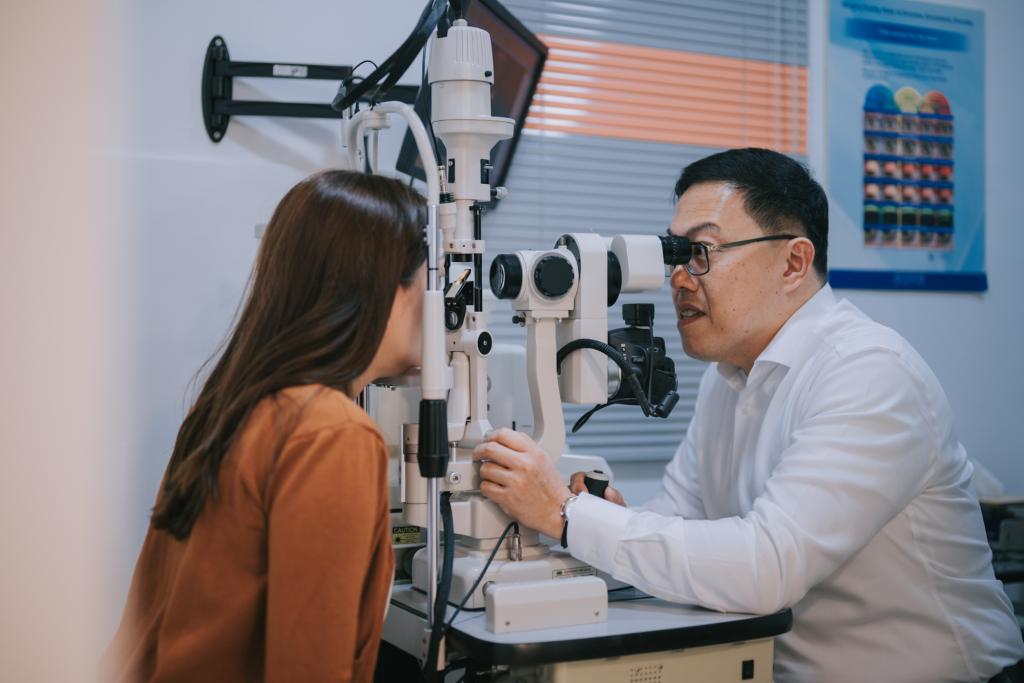I. Introduction of Slit Lamp Examinations for Individuals with Diabetes in Malaysia
Overview of Slit Lamp Examination
Slit lamp examinations are crucial for individuals with diabetes due to their high risk of developing eye diseases. This examination utilizes a microscope-like device to inspect the frontal eye structures in detail, including the cornea, iris, and lens, allowing for the early detection and management of conditions like diabetic retinopathy.

Diabetes in Malaysia: A Growing Concern
Recent data indicates that approximately 18.3% of the adult population in Malaysia, roughly 3.9 million people, suffer from diabetes. The prevalence is particularly alarming in states like Negri Sembilan and Perlis, where it exceeds 30% ([The Star](https://www.thestar.com.my/news/nation/2023/11/30/almost-20-of-malaysian-adults-have-diabetes-says-dr-zaliha)).
The rising trend in diabetes has significant implications for public health and the healthcare system, contributing to increased rates of kidney failure and other severe complications ([Malay Mail](https://www.malaymail.com/news/malaysia/2023/11/05/health-experts-predict-diabetes-will-heavily-burden-malaysias-healthcare-system-in-future/56911)).

Importance of Regular Eye Examinations
Regular eye screenings, including slit lamp examinations, are essential for diabetic patients to prevent complications such as blindness. Early detection through these examinations can significantly alter the progression of diabetic eye diseases, making regular check-ups a critical component of diabetes management.
Government Initiatives and Health Programs
The Malaysian government has initiated several programs to combat the diabetes epidemic, such as the National Health Screening Initiatives (NHSI), which focus on identifying individuals with high blood sugar levels. These initiatives are crucial for early intervention and management of diabetes and its associated complications.
References
- “Almost 20% of Malaysian adults have diabetes, says Dr Zaliha.” The Star. [Article Link](https://www.thestar.com.my/news/nation/2023/11/30/almost-20-of-malaysian-adults-have-diabetes-says-dr-zaliha)
- “Health experts predict diabetes will heavily burden Malaysia’s healthcare system in future.” Malay Mail. [Article Link](https://www.malaymail.com/news/malaysia/2023/11/05/health-experts-predict-diabetes-will-heavily-burden-malaysias-healthcare-system-in-future/100416)
II. Understanding Diabetic Eye Diseases in Malaysia
Overview of Diabetic Eye Diseases
Diabetic eye diseases, including diabetic retinopathy, diabetic macular edema, and cataracts, represent some of the most common and severe complications of diabetes. These conditions arise primarily from the prolonged effects of high blood sugar levels, which can damage the tiny blood vessels in the retina, leading to vision loss if not managed appropriately.
Diabetic Retinopathy: Prevalence and Impact
Diabetic retinopathy stands as the primary reason for vision impairment and blindness among working-age adults in Malaysia.

A recent study highlighted that the prevalence of diabetic retinopathy among known diabetic subjects in Malaysia is approximately 21%, with a higher incidence reported among men compared to women (T. Naveenkumar et al.).
This condition progresses from mild non-proliferative abnormalities, characterized by balloon-like swelling of the blood vessels, to more severe proliferative diabetic retinopathy, where abnormal new blood vessels proliferate on the retina’s surface.
Diabetic Macular Edema: A Closer Look
Diabetic macular edema (DME), often a consequence of diabetic retinopathy, involves the accumulation of fluid in the macula—part of the retina responsible for clear, straight-ahead vision. The condition causes significant vision blur and can severely impair the quality of life. The management of DME often requires a multifaceted approach, including control of diabetes and direct treatments to reduce macular swelling.

Cataracts and Diabetes: The Connection
Individuals with diabetes have a two to fivefold higher risk of developing cataracts compared to the general population. Cataracts cause the eye’s lens to cloud, obstructing vision. They develop at an earlier age in diabetics and progress more rapidly than in individuals without diabetes.

Preventive Measures and Treatments
Prevention and treatment strategies for diabetic eye diseases include rigorous management of blood glucose levels, hypertension, and lipid levels to reduce or delay the onset of eye complications. Regular eye exams, including slit lamp examinations, are critical for early detection and treatment.
References
- T. Naveenkumar, T. NagiReddy, N. Radhakishan. “Diabetic eye screening in multi ethnic population of Malaysia: epidemiological risk factors for development of diabetic retinopathy.” [Link to the study](https://dx.doi.org/10.5455/2320-6012.IJRMS201408069)
III. Role of Slit Lamp Examination in Diabetic Eye Care in Malaysia
Essential Role of Slit Lamp Examinations
Slit lamp examinations are indispensable in diabetic eye care for their ability to provide a detailed and magnified view of the eye’s structures. This examination is crucial in identifying early signs of complications associated with diabetes, such as changes in the cornea, iris, lens, and particularly the retina.
Detecting Diabetic Retinopathy
One of the primary uses of slit lamp examinations in diabetic patients is the detection and management of diabetic retinopathy, a condition that can lead to blindness if untreated. These examinations allow ophthalmologists to observe the retina for signs of damage, such as microaneurysms, hemorrhages, and other vascular abnormalities, which are indicative of diabetic retinopathy.
According to a study by Blake A. Cooper, slit lamp examinations are critical in the early detection and monitoring of diabetes-related retinal diseases, which facilitates timely intervention ([Blake A. Cooper](https://diabetesjournals.org/compendia/article-pdf/2022/3/4/686363/db202234.pdf)).
Monitoring Progression and Treatment
Slit lamp examinations are not only vital for the detection of diabetic eye diseases but also for monitoring the progression of these conditions over time. This monitoring is crucial in evaluating the effectiveness of the prescribed treatments, such as laser therapy or pharmacological interventions. The detailed visualization provided by the slit lamp helps in guiding treatment decisions, which are based on the severity and progression of retinal and macular changes.
Preventive Care and Management
Regular slit lamp examinations are essential for the preventive eye care of diabetic patients. These examinations allow for the early diagnosis of diabetic eye diseases, thereby facilitating timely management and preventing severe complications such as vision loss.
According to R. Klein, consistent monitoring through eye examinations is crucial for managing eye disease in insulin-dependent diabetic patients, emphasizing the prevention of visual loss through early detection ([R. Klein](https://pubmed.ncbi.nlm.nih.gov/6562666)).
Furthermore, A. Phillips highlights the significance of regular eye screening, noting its critical role in reducing risk factors associated with diabetic retinopathy and saving sight. This screening is particularly vital for encouraging diabetic patients to understand the importance of regular eye check-ups as part of their overall diabetes care ([A. Phillips](https://dx.doi.org/10.12968/IJOP.2014.5.3.96)).
References
- Blake A. Cooper, “Ten Key Elements of a Diabetes-Related Eye Examination.” [Article Link](https://diabetesjournals.org/compendia/article-pdf/2022/3/4/686363/db202234.pdf)
- R. Klein, “Management of eye disease in the insulin-dependent diabetic patient.” [Article Link](https://pubmed.ncbi.nlm.nih.gov/6562666)
- A. Phillips, “Diabetes and eye health: screening for diabetic retinopathy.” [Article Link](https://dx.doi.org/10.12968/IJOP.2014.5.3.96)
IV. Conclusion: The Importance of Slit Lamp Examinations for Diabetic Patients in Malaysia
Essential Role of Slit Lamp Examinations
Slit lamp examinations are not merely routine tests; they are critical components of comprehensive eye care for individuals with diabetes. These examinations enable healthcare professionals to view the front and back of the eye in detail, crucial for detecting early changes that could indicate the onset of diabetic eye diseases.
The ability to observe these structures in high resolution helps in diagnosing issues at an early stage, potentially preventing conditions like diabetic retinopathy from advancing to more severe stages that can lead to vision loss.
Preventing Progression of Diabetic Eye Diseases
Regular slit lamp examinations allow for the ongoing monitoring of changes in the eye caused by diabetes. By catching these changes early, treatments can be applied more effectively, thereby slowing or even halting the progression of eye diseases.
In Malaysia, where diabetes prevalence is high, the proactive management of eye health through these examinations is particularly vital. It ensures that diabetic individuals receive timely interventions, reducing the risk of complications such as cataracts, glaucoma, and diabetic macular edema.
Conclusion
For individuals with diabetes, particularly in Malaysia where the condition is increasingly common, understanding and utilizing slit lamp examinations are fundamental to preventing eye diseases and maintaining quality of life. Ensuring regular check-ups and staying informed about eye health are essential steps towards effective disease management and vision preservation.

